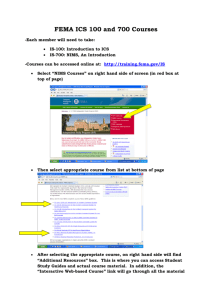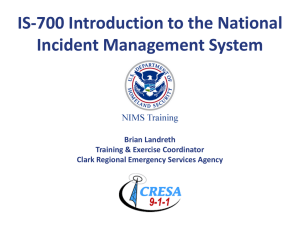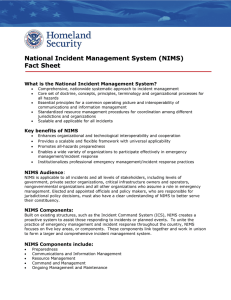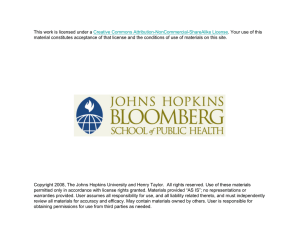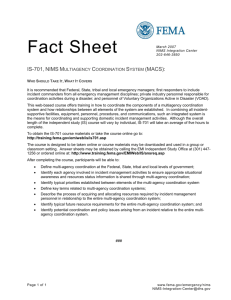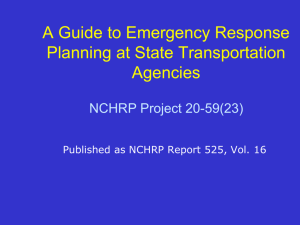National Incident Management System (NIMS) Workshop National Logistics Workshop
advertisement
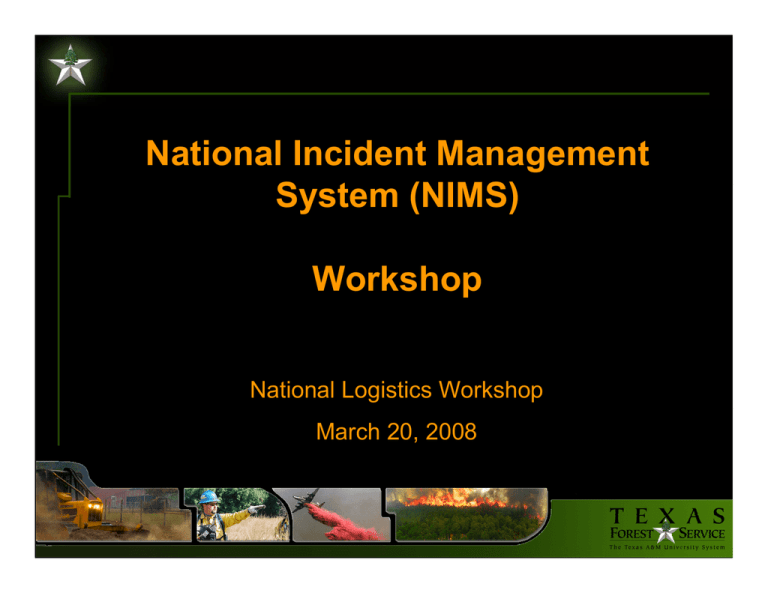
National Incident Management System (NIMS) Workshop National Logistics Workshop March 20, 2008 NIMS Websites • NIMS Integration Center http://www.fema.gov/emergency/nims/ • NIMS Training http://www.fema.gov/emergency/nims/nims_training.shtm • EMI Training http://training.fema.gov/EMIWeb/ • IS 700 NIMS http://training.fema.gov/EMIWeb/IS/IS700.asp • IS 701 – Multi-Agency Coordination http://training.fema.gov/EMIWeb/IS/IS701.asp • IS 800 – National Response Framework http://training.fema.gov/EMIWeb/IS/IS800b.asp NIMS Changes • New updated NIMS Document • New updated National Response Framework Document • Rearranged the Components of NIMS • “Intelligence/Information function” changed to “Intelligence /Investigation function” • Credentialing Revised Federal Response Document - NRF • On September 10, 2007, the Department of Homeland Security's Federal Emergency Management Agency (FEMA) completed an extensive review of the National Response Plan (NRP). • As a result of this review, the NRP was renamed the National Response Framework (NRF), and changes were made to better align the document with its intended purpose. NATIONAL RESPONSE FRAMEWORK • Retains the same core principles contained in the National Incident Management System (NIMS) by which first responders from different jurisdictions and disciplines can work together to respond to natural disasters and emergencies, including acts of terrorism. NATIONAL RESPONSE FRAMEWORK • Also encourages a higher state of readiness by drawing a sharper focus on the value of preparedness activities that can improve response across all jurisdictions: planning, organizing, training, equipping, exercising, and applying lessons learned. • Mastery of these key tasks supports unity of effort, and thus our ability to save lives, protect property, and meet basic human needs. NATIONAL RESPONSE FRAMEWORK • INTRODUCTION – Overview – Framework unpacked – Scope – Response Doctrine – Part of a Broader Strategy NATIONAL RESPONSE FRAMEWORK • This National Response Framework (NRF) [or Framework] is a guide to how the Nation conducts all-hazards response. • The term “response” as used in this Framework includes immediate actions to save lives, protect property and the environment, and meet basic human needs. • The Framework is written especially for government executives, private-sector and nongovernmental organization (NGO) leaders, and emergency management practitioners. NATIONAL RESPONSE FRAMEWORK • One of the challenges to effective response is the relatively high turnover and short tenure among elected and appointed officials responsible for response at all levels. • This document is an outgrowth of previous iterations of Federal planning documents. • By adopting the term “framework” within the title, this document is now more accurately aligned with its intended purpose. NATIONAL RESPONSE FRAMEWORK • CHAPTER I – ROLES AND RESPONSIBILITIES – This chapter sharpens the focus on who is involved with emergency management activities at the local, tribal, State, and Federal levels and with the private sector and NGOs. NATIONAL RESPONSE FRAMEWORK • CHAPTER II – RESPONSE ACTIONS • This chapter describes what we as a Nation collectively do to respond to incidents. • Prepare • Respond • Recover NATIONAL RESPONSE FRAMEWORK CHAPTER II – RESPONSE ACTIONS •Prepare •Respond •Recover NATIONAL RESPONSE FRAMEWORK • CHAPTER III – RESPONSE ORGANIZATION – This chapter explains how we as a Nation are organized to implement response actions. – Key Concepts – Local Response: Structures and Staffing – State Response: Structures and Staffing – Federal Response: Structures and Staffing NATIONAL RESPONSE FRAMEWORK • CHAPTER IV – PLANNING: A CRITICAL ELEMENT OF EFFECTIVE RESPONSE – This chapter emphasizes the importance of planning and summarizes the elements of national planning structures. – The Framework and Planning – The Value of Planning – National Preparedness Architecture – The Federal Planning Structure – The State, Tribal, and Local Planning Structure – Criteria for Successful Planning NATIONAL RESPONSE FRAMEWORK • CHAPTER V – ADDITIONAL RESOURCES – This final chapter summarizes the content and plan for the online NRF Resource Center – Supporting Documents – Effective Date and Framework Implementation NATIONAL RESPONSE FRAMEWORK • The National Response Framework is comprised of: – Core document – Emergency Support Function (ESF), – Support, and Incident Annexes – Partner Guides. NATIONAL RESPONSE FRAMEWORK • Emergency Support Function Annexes group Federal resources and capabilities into functional areas that are most frequently needed in a national response (e.g., Transportation, Firefighting, Mass Care). • Support Annexes describe essential supporting aspects that are common to all incidents (e.g., Financial Management, Volunteer and Donations Management, Private-Sector Coordination). NATIONAL RESPONSE FRAMEWORK • Incident Annexes address the unique aspects of how we respond to seven broad incident categories (e.g., Biological, Nuclear/Radiological, Cyber, Mass Evacuation). • Partner Guides provide ready references describing key roles and actions for local, tribal, State, Federal, and private-sector response partners. Revised NIMS Document • The NIMS document was revised in 2007 to reflect contributions from stakeholders around the Nation and lessons learned from recent incidents. • The revision focused on clarifying concepts, issues, and topics within the document without any major policy changes. • The document was reorganized to reflect the linear progression of emergency management and incident response, and diagrams and textboxes were added to increase clarity and highlight key concepts. What is the National Incident Management System? • NIMS provides a systematic, proactive approach guiding departments and agencies at all levels of government , the private sector, nongovernmental organizations to work seamlessly to prepare for, prepare for, prevent, respond to, recover from, and mitigate the effects of incidents, regardless of cause, size, location, or complexity, in order to reduce the loss of life, property, and harm to the environment NIMS Document • • • • • • • INTRODUCTION AND OVERVIEW Introduction Concepts and Principles Flexibility Standardization Overview of NIMS Components NIMS Components NIMS Components • COMMAND AND MANAGEMENT • PREPAREDNESS • RESOURCE MANAGEMENT • COMMUNICATIONS AND INFORMATION MANAGEMENT • SUPPORTING TECHNOLOGIES • ONGOING MANAGEMENT AND MAINTENANCE • • • • • 2008 PREPAREDNESS COMMUNICATIONS AND INFORMATION MANAGEMENT RESOURCE MANAGEMENT COMMAND AND MANAGEMENT ONGOING MANAGEMENT AND MAINTENANCE PREPAREDNESS • Concepts and Principles – Unified Approach – Levels of Capability • Achieving Preparedness – Relationship between NIMS and Other Preparedness Efforts – NIMS and its Relationship to the National Response Framework – Preparedness Roles – Preparedness Elements – Mitigation COMMUNICATIONS AND INFORMATION MANAGEMENT • Concepts and Principles – Common Operating Picture – Interoperability – Reliability, Suitability, and Portability – Resiliency and Redundancy • Management Characteristics – Standardized Communication Types – Policy and Planning – Agreements – Equipment Standards and Training COMMUNICATIONS AND INFORMATION MANAGEMENT • Organization and Operations – Incident Information – Communications Standards and Formats RESOURCE MANAGEMENT • Concepts and Principles – Concepts – Principles • Managing Resources – Identify Requirements – Order and Acquire – Mobilize – Track and Report – Recover and Demobilize – Reimburse – Inventory COMMAND AND MANAGEMENT • Incident Command Systems – Management Characteristics – Incident Command and Command Staff – General Staff – Incident Management Teams – Incident Complex – Multiple Incident Management with a Single ICS Organization – Area Command COMMAND AND MANAGEMENT • Multiagency Coordination Systems – Definition – System Elements – Examples of System Elements – Primary Functions of Multiagency Coordination Systems – Difference Between a Multiagency Coordination Group and area Command COMMAND AND MANAGEMENT • Public Information – Introduction – System Description and Components – Public Information Communications Planning • Relationships Among Command and Management Elements ONGOING MANAGEMENT AND MAINTENANCE • National Integration Center – Concepts and Principles – NIMS Revision Process – NIC Responsibilities • Supporting Technologies – Concepts and Principles – Supporting Incident Management with Science and Technology Intelligence/Investigation Function • Can be a unit within Plans Section • Can be a Separate General Staff section • Can be a Group or Branch within Operations Section • Can be a member of the Command Staff • Why do you care? You have to take care of their needs. CREDENTIALING • Major focus for FY 2008 • With NIMS/NRF, there will be Needed Functional Capabilities • With each position, there are Core Competencies & Associated Behaviors • If you are not qualified already, must meet those Competencies and Behaviors. • For training, there will training guidance with NIMS Core Curriculum. • Receive CREDENTIALS WHAT DOES THIS MEAN TO LOGISTICANS • We are considered to be the experts in ICS • We don’t own ICS anymore • ICS is a part of the National Incident Management System • Important that you understand NIMS changes and are capable of talking the talk Course Scope/Competencies CORE COMPETENCIES HAZARD-SPECIFIC COMPETENCIES 1-11 Position Task Books 1-12 Position Task Book • Competencies – A broad description that groups core behaviors necessary to perform a specific function. – Behaviors – A general description of an observable activity or action demonstrated by an individual in a particular context. » Tasks– A specific description of a unit of work activity that is a logical and necessary action in the performance of a behavior; how the behavior is demonstrated or performed in a particular context. Again, these are signed-off by qualified evaluators. Position Task Book • Competencies – Lead assigned personnel –Behaviors – Establish work assignments and performance expectations, monitor performance, and provide feedback »Tasks– Complete daily review of staffing requirements and ensure adequate personnel needs »Ensure subordinates understand assignment for operational period QUESTIONS??? Paul Hannemann Texas Forest Service phannemann@tfs.tamu.edu Ph. 979-458-7344
